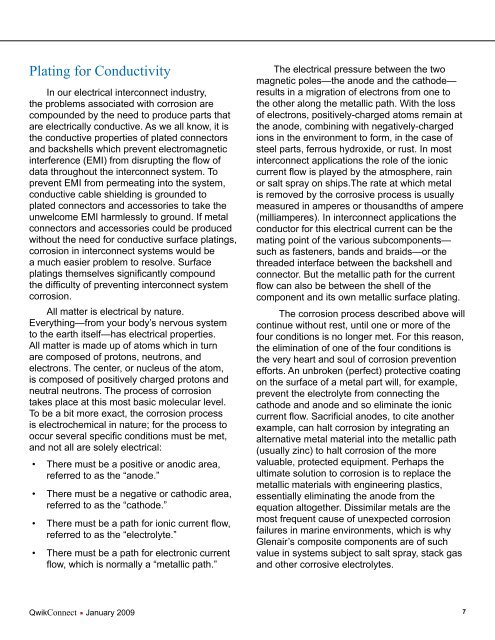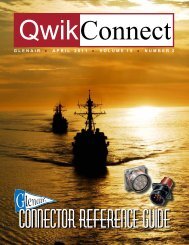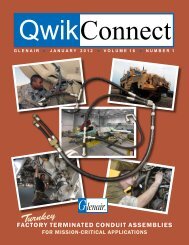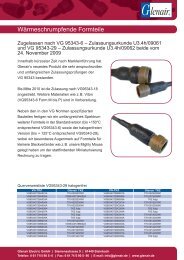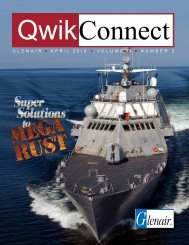RoHS - Glenair UK Ltd
RoHS - Glenair UK Ltd
RoHS - Glenair UK Ltd
You also want an ePaper? Increase the reach of your titles
YUMPU automatically turns print PDFs into web optimized ePapers that Google loves.
Plating for Conductivity<br />
In our electrical interconnect industry,<br />
the problems associated with corrosion are<br />
compounded by the need to produce parts that<br />
are electrically conductive. As we all know, it is<br />
the conductive properties of plated connectors<br />
and backshells which prevent electromagnetic<br />
interference (EMI) from disrupting the flow of<br />
data throughout the interconnect system. To<br />
prevent EMI from permeating into the system,<br />
conductive cable shielding is grounded to<br />
plated connectors and accessories to take the<br />
unwelcome EMI harmlessly to ground. If metal<br />
connectors and accessories could be produced<br />
without the need for conductive surface platings,<br />
corrosion in interconnect systems would be<br />
a much easier problem to resolve. Surface<br />
platings themselves significantly compound<br />
the difficulty of preventing interconnect system<br />
corrosion.<br />
All matter is electrical by nature.<br />
Everything—from your body’s nervous system<br />
to the earth itself—has electrical properties.<br />
All matter is made up of atoms which in turn<br />
are composed of protons, neutrons, and<br />
electrons. The center, or nucleus of the atom,<br />
is composed of positively charged protons and<br />
neutral neutrons. The process of corrosion<br />
takes place at this most basic molecular level.<br />
To be a bit more exact, the corrosion process<br />
is electrochemical in nature; for the process to<br />
occur several specific conditions must be met,<br />
and not all are solely electrical:<br />
•<br />
•<br />
•<br />
•<br />
There must be a positive or anodic area,<br />
referred to as the “anode.”<br />
There must be a negative or cathodic area,<br />
referred to as the “cathode.”<br />
There must be a path for ionic current flow,<br />
referred to as the “electrolyte.”<br />
There must be a path for electronic current<br />
flow, which is normally a “metallic path.”<br />
QwikConnect n·<br />
January 2009<br />
The electrical pressure between the two<br />
magnetic poles—the anode and the cathode—<br />
results in a migration of electrons from one to<br />
the other along the metallic path. With the loss<br />
of electrons, positively-charged atoms remain at<br />
the anode, combining with negatively-charged<br />
ions in the environment to form, in the case of<br />
steel parts, ferrous hydroxide, or rust. In most<br />
interconnect applications the role of the ionic<br />
current flow is played by the atmosphere, rain<br />
or salt spray on ships.The rate at which metal<br />
is removed by the corrosive process is usually<br />
measured in amperes or thousandths of ampere<br />
(milliamperes). In interconnect applications the<br />
conductor for this electrical current can be the<br />
mating point of the various subcomponents—<br />
such as fasteners, bands and braids—or the<br />
threaded interface between the backshell and<br />
connector. But the metallic path for the current<br />
flow can also be between the shell of the<br />
component and its own metallic surface plating.<br />
The corrosion process described above will<br />
continue without rest, until one or more of the<br />
four conditions is no longer met. For this reason,<br />
the elimination of one of the four conditions is<br />
the very heart and soul of corrosion prevention<br />
efforts. An unbroken (perfect) protective coating<br />
on the surface of a metal part will, for example,<br />
prevent the electrolyte from connecting the<br />
cathode and anode and so eliminate the ionic<br />
current flow. Sacrificial anodes, to cite another<br />
example, can halt corrosion by integrating an<br />
alternative metal material into the metallic path<br />
(usually zinc) to halt corrosion of the more<br />
valuable, protected equipment. Perhaps the<br />
ultimate solution to corrosion is to replace the<br />
metallic materials with engineering plastics,<br />
essentially eliminating the anode from the<br />
equation altogether. Dissimilar metals are the<br />
most frequent cause of unexpected corrosion<br />
failures in marine environments, which is why<br />
<strong>Glenair</strong>’s composite components are of such<br />
value in systems subject to salt spray, stack gas<br />
and other corrosive electrolytes.<br />
7


